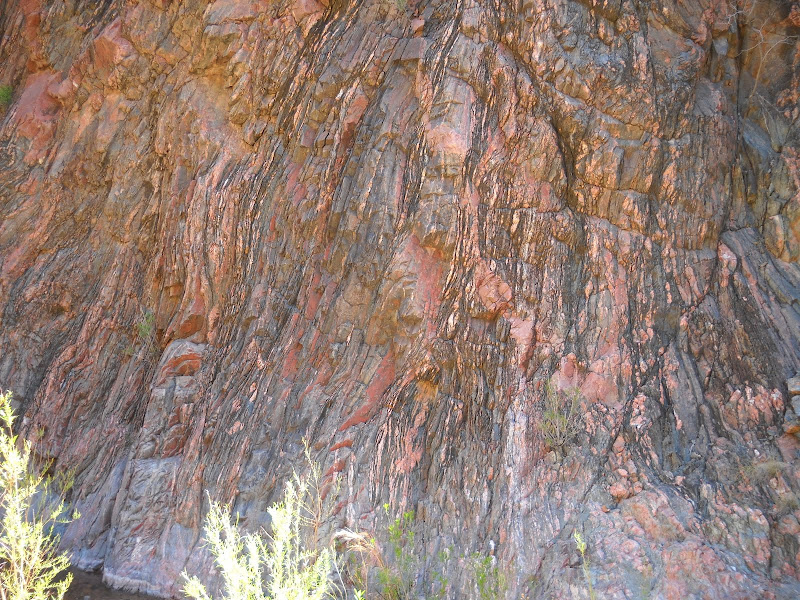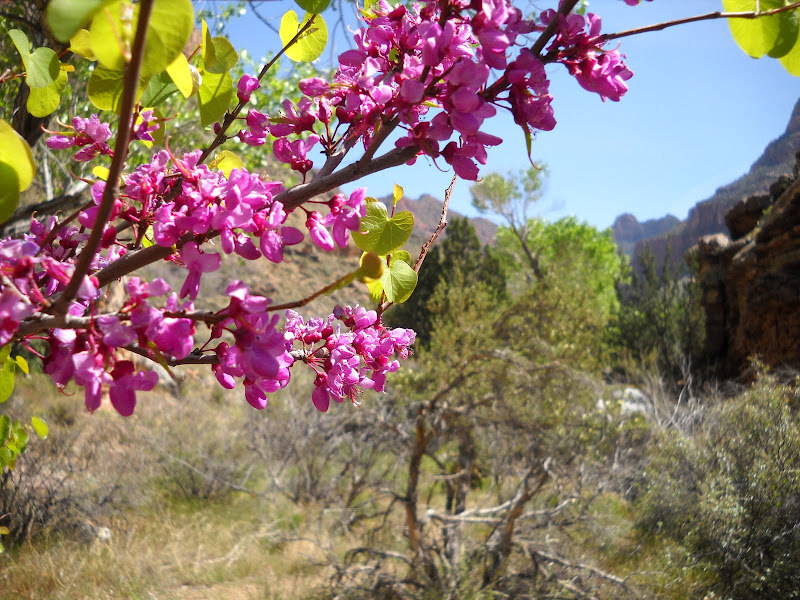
Spending two nights at Hance Creek pretty much by my lonesome (well, except for a few random hikers and the frogs) has done wonders for my state of mind. Not that I am distressed, but I do spend winter dealing with lots of people, and sometimes you just need to get away. Besides isolation, surrounding myself with resplendent scenery helps me focus on what lies ahead for the summer.
 Packing up camp and loading all the gear back into the pack, I get a reasonably early start along the way to my next waypoint - Cottonwood Creek.
Packing up camp and loading all the gear back into the pack, I get a reasonably early start along the way to my next waypoint - Cottonwood Creek. Except for being located on the west side of Horseshoe Mesa, Cottonwood could be a fraternal twin to Hance. Getting there is a relatively easy (as far as Grand Canyon trails go) 5 mile hike along one of my favorite trails: the Tonto.
Tonto trail has the distinction of being the only practical east-west route through central Grand Canyon. Stretching over 95 miles, hikers utilize the Tonto to connect with most rim-to-river routes, allowing for multiple choices in trip itineraries. The beauty of this trail is that it's located well below the rim but above the River, so in many instances views are all-encompassing and panoramic.



The Tonto trail is like a contour line on the map. Staying at approximately the same elevation it follows the path of least resistance, which in terms of Canyon geography is definitely not the most direct route, or in many cases the easiest. As there are many side canyons and drainages (erosion channels not yet big enough to be called canyons) that feed into the Inner Gorge, the path must wind its way in and out innumerable times, leaving hikers who wish to make quick progress frustrated at times. And though in most cases there are no significant elevation changes on the Tonto, that doesn't mean there aren't plenty of ups and downs as the trail must negotiate every pleat and fold of the terrain.
Many times hiking here it is easy to lose perspective because the trail is confined within the walls of a canyon. Since everything you see is on a massive scale, visitors still feel dwarfed by the enormity, yet the bigger picture is missing. Only on the Tonto, floating somewhere above the deepest chasm and below the soaring ramparts overhead does it begin to make sense. This is why I like hiking here.



After leaving the yawning bay of Hance Creek, the trail circumnavigates westward along the base of Horsehoe Mesa, eventually turning back south into the mouth of Cottonwood Creek.

After a few hours spent trundling along the Tonto with my thoughts, I see the first glimpse of a tiny ribbon of water and verdant green trees ahead. Once again I arrive well before any other visitors, and pick out a delightful spot next to the creek, with an outcropping of Tapeats that will soon provide afternoon shade.

As always I give thanks for the gift of flowing water. Like Hance Creek, Cottonwood provides just enough to support a wonderful diversity of plants and animals, as well as a few thirsty hikers.


This lizard probably doesn't drink much, but I'll bet he feasts on insects drawn to the stream.

The rest of the afternoon and evening pass all too quickly, and soon I find myself preparing for bed. Fortunately the frogs here are fewer in number or perhaps have diminished libido, leaving me to fall asleep quickly. I want to rise early in the hopes of beating the sun before it rises over the Mesa.
By 7:30 I am packed and ready to go. I repeat the Grand Canyon hiker's mantra to myself: One foot in front of the other. I also like the proverb which states the best way to eat an elephant is "one bite at a time". Even though the uphill climb is hard I'm glad I'm hiking instead of eating a pachyderm.

The overall trail out is steep, but the hardest section comes right away - the climb back onto the Mesa through the Redwall. It's a real grunt, but eventually I reach the top.

Once on the Mesa, I take a minute to check out the remains of an old stone cabin left from the days of copper mining. The Mesa and surrounding area are strewn with odds and ends from the late 1800's and early 1900's. It's funny to consider that back then, these guys were just discarding what was broken or no longer useful, something that is called littering today. It makes me wonder if archaeologists and historians of the future will view our detritus the same way.

The remaining 3 miles and 2400 feet await me. I am not as sore as I was when I first arrived a few days earlier, but even so it will take willpower and many breaks to climb out of the Canyon. Still I know the effort is well worth it, for the time I've spent here is more precious to me than just about anything. In fact, I'm already thinking about the next trip.














































